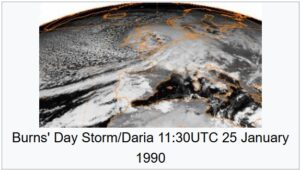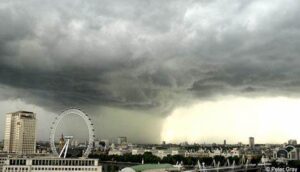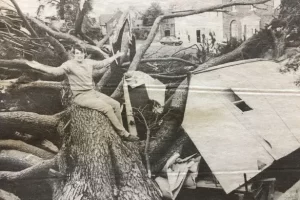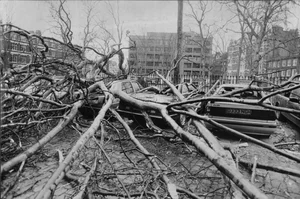
 Normally, we think of tornadoes or cyclones as a summertime event, but there is a different kind of a cyclone, known as a bomb cyclone, that can happen in the winter too. The Burns’ Day Storm, which began as Cyclone Daria, was an extremely violent windstorm that took place on January 25-26, 1990, over north-western Europe. Daria was one of the strongest European windstorms on record. It caused many fatalities in the UK and Europe. Because Europe has no official list of storm names, this storm was given several names. Cyclone Daria started on the birthday of Scottish poet Robert Burns, so it was dubbed The Burn’s Day Storm. It caused widespread damage and hurricane-force winds over a wide area. The storm was responsible for 47 deaths according to the Met Office (the United Kingdom’s national weather and climate service), although figures have ranged from 89 to over 100 deaths across Europe.
Normally, we think of tornadoes or cyclones as a summertime event, but there is a different kind of a cyclone, known as a bomb cyclone, that can happen in the winter too. The Burns’ Day Storm, which began as Cyclone Daria, was an extremely violent windstorm that took place on January 25-26, 1990, over north-western Europe. Daria was one of the strongest European windstorms on record. It caused many fatalities in the UK and Europe. Because Europe has no official list of storm names, this storm was given several names. Cyclone Daria started on the birthday of Scottish poet Robert Burns, so it was dubbed The Burn’s Day Storm. It caused widespread damage and hurricane-force winds over a wide area. The storm was responsible for 47 deaths according to the Met Office (the United Kingdom’s national weather and climate service), although figures have ranged from 89 to over 100 deaths across Europe.
The storm began as a cold front over the Northern Atlantic Ocean on January 23rd. By the 24th, it had a minimum central pressure of 992 mbar and began to undergo explosive cyclogenesis, sometimes referred to as a weather bomb. That is what makes it so dangerous. Cyclone Daria made landfall on the morning of the 25th over Ireland. It then tracked over to Ayrshire in Scotland. The lowest pressure of 949 mbar was estimated near Edinburgh around 4:00pm. After pounding the United Kingdom, the storm tracked rapidly east towards Denmark. Thus, causing major damage and 30 deaths in the Netherlands and Belgium.
Cyclone Daria’s strongest sustained winds recorded were between 70 and 75 mph, which is basically a weak Category 1 hurricane or Hurricane-force 12 on the Beaufort Scale. Strong gusts of up to 104 miles per hour were also reported. It was these strong gusts caused the most extensive damage. During the Great Storm of 1987, many anemometers stopped recording due to power outages, breakages due to excess wind speeds and measurement maxima being exceeded, but by the 1990 Cyclone Daria, the meteorological community had newer devices that remained independent of external power and could measure higher wind speeds. It is believed that wind speeds measured during the Burns’ Day Storm provided an accurate picture.
The Burns’ Day Storm of 1990 has been given as an example of when the Met Office “got the prediction right”. We often joke about the weather service, and just how famously inaccurate they can be, but we do appreciate them when they get it right, if we heed their warnings anyway. In this case, the model forecast hinged on observations from two ships in the Atlantic near the developing storm the day before it reached the UK.
During the day of the storm the Royal Netherlands Meteorological Institute (KNMI) increased warnings to force 11 and then to hurricane force 12. Research has shown that most of the general public simply couldn’t comprehend just how bad this storm was. Cyclones, after all don’t usually happen in winter. While unusual, the aftermath of this storm led to more awareness about the understanding of storminess among the public by the KNMI (Koninklijk Nederlands Meteorologisch Instituut), who started a teletext page and the introduction of special warnings for extreme weather events in reaction to these findings.
The casualties in Cyclone Daria were much higher than those of the Great Storm of 1987, partly because the storm hit during the daytime. More people were out and about. The storm caused extensive damage, with approximately 3 million trees downed, power disrupted to over 500,000 homes and severe flooding in England and West Germany. The storm cost insurers in the UK £3.37 billion, which was the UK’s most expensive 
 weather event to insurers. Most of the deaths were caused by collapsing buildings or falling debris. There were a few miracles too, however. In one case in Sussex, a class of children was evacuated just minutes before their school building collapsed. Actor Gorden Kaye was also injured during the storm, when a plank of an advertising board was blown through his car’s windshield.
weather event to insurers. Most of the deaths were caused by collapsing buildings or falling debris. There were a few miracles too, however. In one case in Sussex, a class of children was evacuated just minutes before their school building collapsed. Actor Gorden Kaye was also injured during the storm, when a plank of an advertising board was blown through his car’s windshield.


Leave a Reply